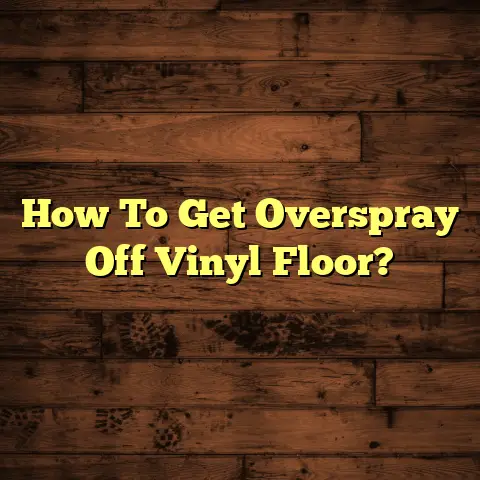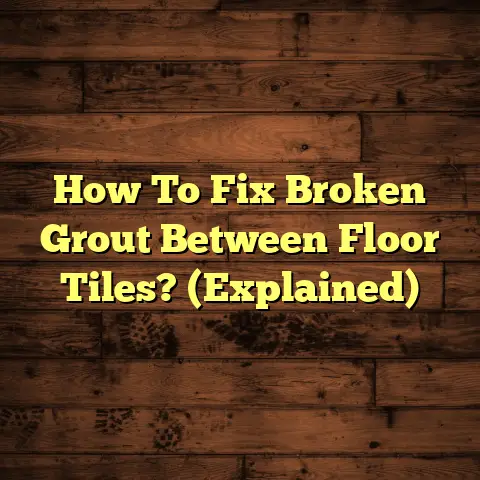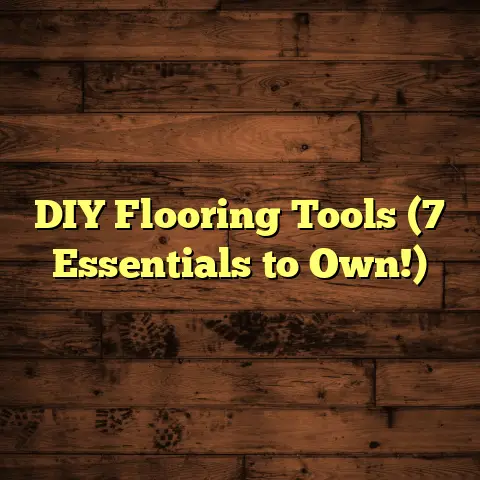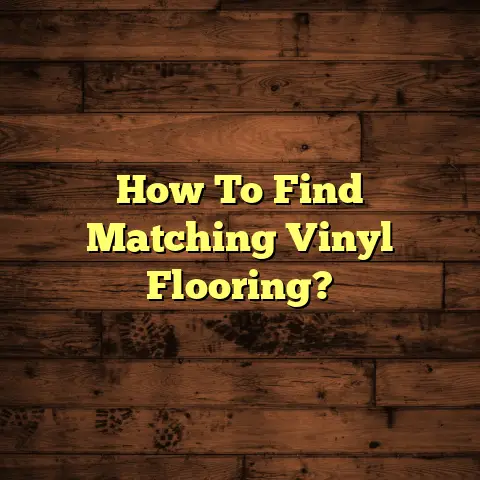Baby-Safe Floor Cleaners (3 May Cause Harm!)
Not all floor cleaners labeled as ‘baby-safe’ are truly safe for your little ones—some may contain harmful ingredients that pose serious health risks!
Now, as a contractor, I’m not just about
installing floors; I’m also deeply concerned
about what we use to maintain them, especially
when babies and toddlers are involved.
Think
about it: our little ones spend a ton of time
on the floor, exploring, playing, and yes, even
putting things in their mouths!
We all want to keep our homes sparkling clean,
right?
So, we reach for those floor cleaners
promising a baby-safe environment.
But here’s
the thing: not everything marketed as “baby-safe”
actually is.
It’s a jungle out there, and
companies often use clever marketing to make
their products seem harmless.
I’ve seen firsthand the effects of some of
these so-called “safe” cleaners, and it’s not
pretty.
That’s why I’m writing this article –
to shed light on the potential dangers lurking
in some commonly used floor cleaners and to
empower you to make informed choices.
We’ll dive into what “baby-safe” really means,
uncover some hidden dangers, explore truly safe
alternatives, and even whip up some DIY
solutions.
So, let’s get started and create
a healthier, safer environment for our little
ones!
Section 1: Understanding Baby-Safe Cleaning Products
Okay, so what does “baby-safe” even mean when
we’re talking about cleaning products?
It’s a
term that gets thrown around a lot, but it’s
important to understand what it really entails.
In the context of household cleaning products,
“baby-safe” generally implies that the product
is non-toxic, free from harsh chemicals, and
won’t cause harm to infants or young children
if they come into contact with it.
Sounds
reassuring, doesn’t it?
But here’s the catch: there’s no universally
recognized standard or legal definition for
“baby-safe” when it comes to cleaning products.
This means that companies can use the term
rather loosely, which can be misleading.
Regulatory Standards and Certifications
So, how do we know if a product is actually
safe?
Well, look for certifications from
reputable organizations.
These certifications
indicate that the product has been tested and
meets certain safety standards.
For example, you might see labels like:
-
EPA Safer Choice: This means the product contains ingredients that are safer for human health and the environment.
-
EcoLogo/UL ECOLOGO: This certification indicates that the product has met rigorous environmental performance standards.
-
Green Seal: This certification signifies that the product has been evaluated for its environmental impact and performance.
These certifications aren’t foolproof, but they do provide an extra layer of assurance.
Marketing Strategies
Let’s talk about marketing.
Companies are
masters at making their products sound appealing,
and they often use phrases like “natural,”
“organic,” and “hypoallergenic” to attract
parents.
But don’t be fooled!
These terms don’t always
mean what you think they mean.
“Natural” doesn’t
necessarily mean safe, and “hypoallergenic”
only means that the product is less likely to
cause an allergic reaction – not that it’s
completely free of irritants.
I’ve seen products with “natural” labels that
still contain harsh chemicals.
It’s all about
reading the ingredient list and doing your
research.
Ingredient Transparency
Speaking of ingredient lists, this is where
things get real.
Ingredient transparency is
crucial for parents.
We need to know exactly
what’s in the products we’re using, so we can
make informed decisions.
Unfortunately, some companies aren’t very
forthcoming about their ingredients.
They might
use vague terms like “fragrance” or “cleaning
agents,” which can hide a whole host of harmful
chemicals.
As a rule of thumb, look for products that
clearly list all of their ingredients.
The
more transparent a company is, the more likely
it is that their product is truly safe.
Section 2: The Hidden Dangers of Baby-Safe Floor Cleaners
Alright, let’s get down to the nitty-gritty.
I’m going to highlight three specific floor
cleaners that are often marketed as baby-safe
but contain potentially harmful ingredients.
I won’t name the exact brands to avoid any
legal issues, but I’ll give you enough
information to identify them and make your
own informed decisions.
Disclaimer: This information is based on my
research and experience as a flooring
contractor.
Always consult with a medical
professional if you have concerns about your
child’s health.
Product 1: The “Natural” Multi-Surface Cleaner
This cleaner is marketed as a natural,
plant-based solution for cleaning various
surfaces, including floors.
It’s often found
in major retailers and online stores.
Key Ingredients and Harmful Chemicals:
Fragrance: This is a big one.
“Fragrance” is often a catch-all term for a cocktail of chemicals, some of which can be harmful.
In this particular cleaner, the fragrance contains phthalates, which are known endocrine disruptors.Sodium Lauryl Sulfate (SLS): SLS is a surfactant that helps to create foam.
While it’s not considered highly toxic, it can be a skin and eye irritant, especially for babies with sensitive skin.
Potential Health Risks:
Endocrine Disruption: Phthalates can interfere with hormone production, which can have long-term health effects, especially during development.
Studies have linked phthalate exposure to reproductive issues, developmental problems, and even certain types of cancer.
(Source: National Institute of Environmental Health Sciences)Skin and Eye Irritation: SLS can cause dryness, itching, and redness, especially in babies with eczema or sensitive skin.
If it gets in the eyes, it can cause stinging and irritation.
Parent Testimonial:
“I used this cleaner because it said ‘natural’
on the label.
My baby started developing a rash
all over her body, and I couldn’t figure out
why.
After doing some research, I realized it
was probably the cleaner.
I switched to a
different product, and the rash cleared up.”
– Sarah M.
Product 2: The “Baby-Friendly” Floor Wipe
These wipes are specifically marketed for
cleaning floors in homes with babies and pets.
They’re convenient and easy to use, but they
may not be as safe as they seem.
Key Ingredients and Harmful Chemicals:
Methylisothiazolinone (MIT): This is a preservative used to prevent the growth of bacteria and mold.
However, it’s also a known skin sensitizer and can cause allergic reactions.Propylene Glycol: This is a solvent that helps to dissolve other ingredients.
It can also be a skin and respiratory irritant.
Potential Health Risks:
-
Allergic Reactions: MIT can cause contact dermatitis, which is a type of allergic reaction that results in itchy, red, and inflamed skin.
-
Respiratory Irritation: Propylene glycol can irritate the lungs and airways, especially in babies with asthma or other respiratory conditions.
Parent Testimonial:
“I loved using these wipes because they were so
easy, but my baby started coughing and wheezing
after I used them.
I didn’t realize it was the
wipes until I stopped using them and his
symptoms improved.” – John B.
Product 3: The “Gentle” Floor Cleaner Concentrate
This is a concentrated floor cleaner that needs
to be diluted with water before use.
It’s
often marketed as gentle and safe for babies
and pets.
Key Ingredients and Harmful Chemicals:
Quaternary Ammonium Compounds (Quats): These are disinfectants that are used to kill bacteria and viruses.
However, they can also be respiratory irritants and may contribute to the development of antibiotic-resistant bacteria.-
Ethanolamine: This is a solvent and emulsifier that can be a skin, eye, and respiratory irritant.
Potential Health Risks:
-
Respiratory Issues: Quats can trigger asthma attacks and other respiratory problems, especially in babies with sensitive airways.
-
Skin and Eye Irritation: Ethanolamine can cause burns and irritation if it comes into contact with the skin or eyes.
Parent Testimonial:
“I thought this cleaner was safe because it said
‘gentle’ on the label, but my baby started
having trouble breathing after I used it.
I
took him to the doctor, and he said it was
probably due to the chemicals in the cleaner.”
– Maria S.
Section 3: Recognizing Safe Alternatives
Okay, so we’ve talked about some of the dangers
lurking in “baby-safe” floor cleaners.
Now,
let’s focus on what parents should look for in
truly safe products.
The key is to prioritize products with:
-
Plant-Based Ingredients: Look for cleaners made with ingredients derived from plants, such as coconut oil, cornstarch, and citrus extracts.
-
Non-Toxic Certifications: As mentioned earlier, certifications like EPA Safer Choice, EcoLogo, and Green Seal can provide extra assurance.
-
Lack of Harmful Fragrances: Opt for unscented products or those scented with essential oils, but be cautious even with essential oils, as some can be irritating to sensitive skin.
Here are a few brands and products that meet these criteria:
-
Better Life: This brand offers a range of plant-based cleaning products that are free from harsh chemicals and artificial fragrances.
-
Puracy: Puracy’s products are made with natural and plant-based ingredients and are certified by Leaping Bunny for being cruelty-free.
-
Common Good: This brand focuses on sustainable and non-toxic cleaning products with refillable packaging.
Remember to always read the ingredient list carefully, even if a product is marketed as “natural” or “baby-safe.”
Section 4: DIY Floor Cleaning Solutions
Want to take things a step further?
Consider
making your own floor cleaning solutions using
natural ingredients.
It’s surprisingly easy,
and you’ll have complete control over what goes
into your cleaner.
Here are a few simple recipes:
DIY All-Purpose Floor Cleaner
Ingredients:
-
1/2 cup white vinegar
-
1 gallon warm water
-
A few drops of essential oil (optional, such as lavender or lemon)
Instructions:
-
Combine the vinegar and water in a bucket.
-
Add essential oil, if desired.
-
Mop your floors as usual.
DIY Wood Floor Cleaner
Ingredients:
-
1/4 cup white vinegar
-
1 gallon warm water
-
1 tablespoon olive oil
Instructions:
-
Combine the vinegar, water, and olive oil in a bucket.
-
Mop your wood floors, making sure to wring out the mop thoroughly to avoid excess water.
DIY Tile Floor Cleaner
Ingredients:
-
1/2 cup baking soda
-
1 gallon warm water
Instructions:
-
Dissolve the baking soda in the water.
-
Mop your tile floors as usual.
These homemade solutions are effective at
cleaning floors without exposing your baby to
harmful chemicals.
Plus, they’re incredibly
affordable!
Conclusion
Choosing safe floor cleaning products for homes
with babies requires vigilance and education.
The term “baby-safe” can be misleading, and
it’s crucial to look beyond marketing claims
and scrutinize ingredient lists.
By understanding the potential dangers of certain chemicals and opting for plant-based alternatives or DIY solutions, you can create a healthier and safer environment for your little ones.
I urge you to advocate for greater transparency
in the cleaning products industry and to share
your experiences with baby-safe cleaners.
Together, we can make a difference and protect
our children from harmful chemicals.
Remember, a clean home shouldn’t come at the
expense of your baby’s health.
Choose wisely,
and breathe easy!





